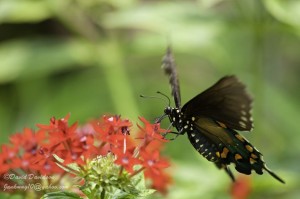
Butterflies are not only beautiful to look at in the landscape; they serve as important pollinators of fruiting plants. Attracting them to the garden and incorporating some features to get them to stay and reproduce involves advanced planning. Some steps to achieve butterfly garden optimization are outlined below.
- Choose a location that provides some protection from wind. Trees and shrubs that provide wind protection also serve as a safe harbor from rain and predators.
- The garden should offer both sunny and partially sunny environments.
- Ensure that any new plantings have access to a convenient irrigation source. A plentiful water source allows butterflies to be successfully established and maintained in good health.
Now plants need to be chosen. Adults feed on the nectar of many flowering trees, shrubs, perennials, and annuals. Fortunately, there are usually many choices that will meet diverse site requirements and varied taste preferences. In order to retain garden butterflies, certain plants need to be available to serve as host plants for their young. Here are a few hits to assist with this selection process.
- Determine which species of butterfly is common in a given geographical area. Most species have very few plants on which the caterpillars can feed, so host plants need to be chosen wisely.
- Determine whether any of the existing plants are host plants and if they are appropriate for a butterfly garden. For example, cassia is a host plant for the Cloudless Sulphur and citrus is a host plant for the Giant Swallowtail.
- In choosing nectar plants, select those that are native or Florida-Friendly as they are lower maintenance, and less troublesome in the long run.
- Choose plants that have flowers in a variety of color, size, and shape. Different butterflies like to feed at different elevations, so choose trees, shrubs, perennials, and annuals of varying heights.
- In order to have nectar available throughout the time when the butterflies occur, include plants that bloom at different times of the year. And include some plants that bloom all the time, like pentas or moss verbena.
Larger plants should be placed in the background with smaller plants layered in the foreground. When planting smaller annuals and perennials, place them in masses to better attract the butterflies. Consider placing host plants in an area that is in close proximity to the nectar plants, but in an area of your garden that is not a focal point. Host plants can get quite ragged looking from hungry caterpillars!
Good maintenance practices will enhance garden health. Regular fertilization, and as needed irrigation, will help keep garden plants in bloom and healthy – healthy plants are less susceptible to disease and pests. Avoid pesticides as they may harm butterflies and other beneficial insects. Never use a Bt or systemic pesticide since these target butterfly larvae. Lower risk oils or soaps are useful in treating localized insect infestations however. Lastly, be aware of beneficial insects that will help achieve satisfactory pest control.
Once the plants are placed there are several things to do to complete the butterfly garden.
- Add a spot where water can puddle on the ground for the adult butterflies to drink. They require minerals from the soil that get dissolved in the water.
- Also add a rock or log in a sunny spot where butterflies can rest and sun themselves.
- Consider placing a comfortable place for you to sit and enjoy the beauty of your garden and its inhabitants!
For more infortmation on butterfly gardening and for a plant list, please check out Butterfly Gardening in Florida
Enjoy the Butterflies !
 0
0
